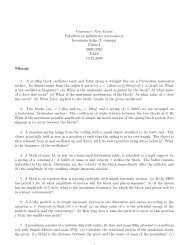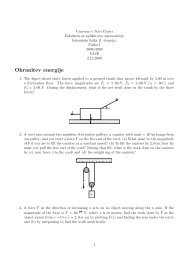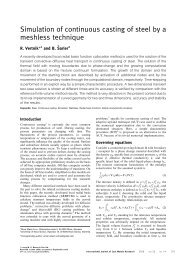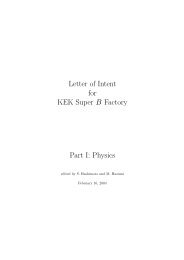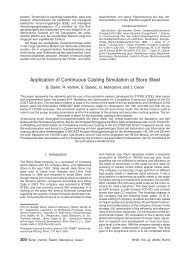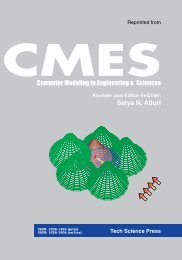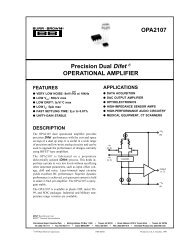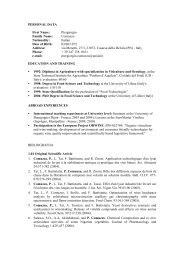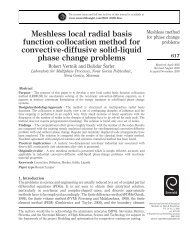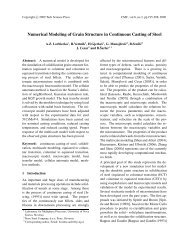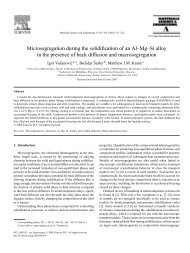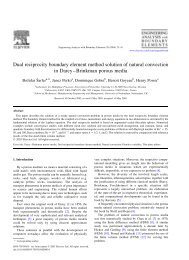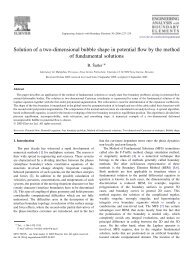Letter of Intent for KEK Super B Factory Part I: Physics
Letter of Intent for KEK Super B Factory Part I: Physics
Letter of Intent for KEK Super B Factory Part I: Physics
Create successful ePaper yourself
Turn your PDF publications into a flip-book with our unique Google optimized e-Paper software.
Table 1.5: B → K (∗) ℓ + ℓ − branching fractions.<br />
Mode Belle (140 fb −1 ) BaBar (113 fb −1 )<br />
[×10 −7 ] [×10 −7 ]<br />
B → Ke + e − 4.8 +1.5<br />
−1.3<br />
B → Kµ + µ − 4.8 +1.3<br />
−1.1<br />
B → Kℓ + ℓ − 4.8 +1.0<br />
−0.9<br />
B → K ∗ e + e − 14.9 +5.2+1.1<br />
−4.6−1.3<br />
B → K ∗ µ + µ − 11.7 +3.6<br />
−3.1<br />
B → K ∗ ℓ + ℓ − 11.5 +2.6<br />
−2.4<br />
events / 5 GeV 2 /c 2<br />
20<br />
15<br />
10<br />
5<br />
0<br />
(a) K * l + l -<br />
± 0.3 ± 0.1 7.9+1.9<br />
−1.7<br />
± 0.3 ± 0.2 4.8+2.5<br />
−2.0<br />
± 0.3 ± 0.1 6.9+1.5<br />
−1.3<br />
± 0.3 10.0+5.0 −4.2<br />
± 0.8 ± 0.6 12.8+7.8 −6.2<br />
± 0.7 ± 0.4 8.9+3.4<br />
−2.9<br />
± 0.7<br />
± 0.4<br />
± 0.6<br />
± 1.3<br />
± 1.7<br />
± 1.1<br />
(b) K l + l -<br />
q 2 (GeV 2 /c 2 0 5 10 15 20 0 5 10 15 20 25<br />
)<br />
Figure 1.10: q 2 distributions <strong>for</strong> B → K (∗) ℓ + ℓ − from Belle.<br />
experimental errors are already much smaller than both the uncertainties in the theoretical predictions<br />
<strong>of</strong> the Standard Model and the variations due to different model-dependent assumptions<br />
used to account <strong>for</strong> the hadronic uncertainties [49–53].<br />
It is still too early to fit the q 2 distribution to constrain new physics. First attempts to<br />
extract the q 2 distribution using the individual Mbc signal yields in q 2 bins have been per<strong>for</strong>med<br />
by Belle as shown in Figure 1.10.<br />
Measurement <strong>of</strong> B → Xsℓ + ℓ −<br />
The first measurements <strong>of</strong> the B → K (∗) ℓ + ℓ− branching fractions are consistent with the Standard<br />
Model predictions. However since these predictions have uncertainties that are already<br />
larger than the measurement errors, the inclusive rate <strong>for</strong> B → Xsℓ + ℓ− becomes more important<br />
in terms <strong>of</strong> the search <strong>for</strong> a deviation from the Standard Model. In contrast to B → Xsγ,<br />
the lepton pair alone does not provide a sufficient constraint to suppress the largest background<br />
from semi-leptonic decays. There<strong>for</strong>e, it is only possible to use the semi-inclusive method to<br />
sum up the exclusive modes <strong>for</strong> now.<br />
Belle has successfully measured the inclusive B → Xsℓ + ℓ− branching fraction [19] from a<br />
60 fb −1 data sample by applying a method that reconstructs the Xs final state with one kaon<br />
(K + or K0 S ) and up to four pions, <strong>of</strong> which one pion is allowed to be a π0 . Assuming the K0 L<br />
contribution is the same as the K 0 S<br />
, this set <strong>of</strong> final states covers 82 ± 2% <strong>of</strong> the signal. In<br />
addition, M(Xs) is required to be below 2.1 GeV in order to reduce backgrounds. For leptons,<br />
a minimum momentum <strong>of</strong> 0.5 GeV <strong>for</strong> electrons, 1.0 GeV <strong>for</strong> muons and M(ℓ + ℓ − ) > 0.2 GeV<br />
21



